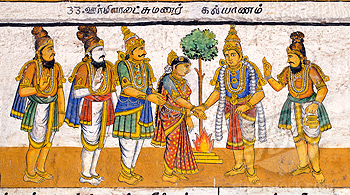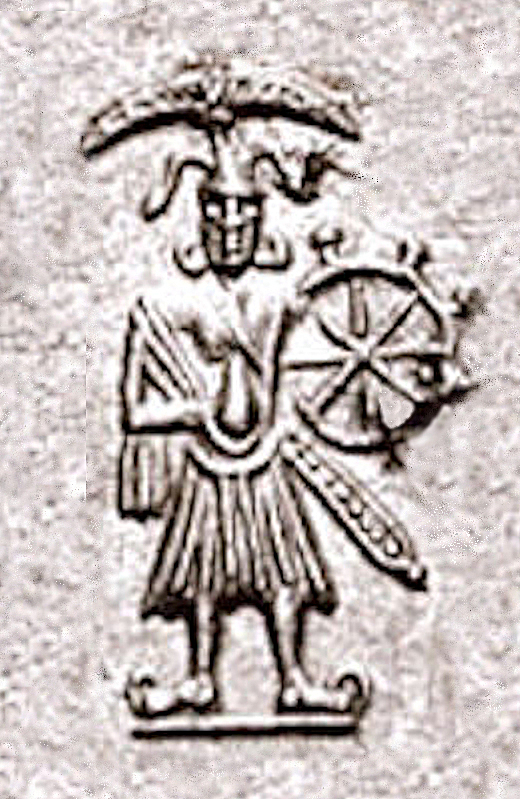|
Rama
Rama (; , , ) is a major deity in Hinduism. He is worshipped as the seventh and one of the most popular avatars of Vishnu. In Rama-centric Hindu traditions, he is considered the Supreme Being. Also considered as the ideal man (''maryāda'' ''puruṣottama''), Rama is the male protagonist of the Hindu epic '' Ramayana''. His birth is celebrated every year on Rama Navami, which falls on the ninth day of the bright half ( Shukla Paksha) of the lunar cycle of Chaitra (March–April), the first month in the Hindu calendar. According to the ''Ramayana'', Rama was born to Dasaratha and his first wife Kausalya in Ayodhya, the capital of the Kingdom of Kosala. His siblings included Lakshmana, Bharata, and Shatrughna. He married Sita. Born in a royal family, Rama's life is described in the Hindu texts as one challenged by unexpected changes, such as an exile into impoverished and difficult circumstances, and challenges of ethical questions and moral dilemmas. The most not ... [...More Info...] [...Related Items...] OR: [Wikipedia] [Google] [Baidu] |
Ramayana
The ''Ramayana'' (; ), also known as ''Valmiki Ramayana'', as traditionally attributed to Valmiki, is a smriti text (also described as a Sanskrit literature, Sanskrit Indian epic poetry, epic) from ancient India, one of the two important epics of Hinduism known as the ''Itihasas'', the other being the ''Mahabharata''. The epic narrates the life of Rama, the seventh ''avatar'' of the Hindu deity Vishnu, who is a prince of Ayodhya (Ramayana), Ayodhya in the kingdom of Kosala. The epic follows Exile of Lord Rama, his fourteen-year exile to the forest urged by his father King Dasharatha, on the request of Rama's stepmother Kaikeyi; his travels across the forests in the Indian subcontinent with his wife Sita and brother Lakshmana; the kidnapping of Sita by Ravana, the king of Lanka, that resulted in bloodbath; and Rama's eventual return to Ayodhya (Ramayana), Ayodhya along with Sita to be crowned as a king amidst jubilation and celebration. Scholarly estimates for the earliest stage ... [...More Info...] [...Related Items...] OR: [Wikipedia] [Google] [Baidu] |
Sita
Sita (; ), also known as Siya, Jānaki and Maithili, is a Hindu goddess and the female protagonist of the Hindu epic ''Ramayana''. Sita is the consort of Rama, the avatar of god Vishnu, and is regarded as an avatar of goddess Lakshmi. She is the chief goddess of the Ramanandi Sampradaya and is the goddess of beauty and devotion. Sita's birthday is celebrated every year on the occasion of Sita Navami. Described as the daughter of Bhūmi (the earth), Sita is brought up as the adopted daughter of King Janaka of Videha. Sita, in her youth, chooses Rama, the prince of Ayodhya (Ramayana), Ayodhya as her husband in a swayamvara. After the Sita Swayamvara, swayamvara, she accompanies her husband to his kingdom but later chooses to accompany him along with her brother-in-law Lakshmana, in his exile. While in exile, the trio settles in the Dandaka forest from where she is abducted by Ravana, the Rakshasa king of Lanka. She is imprisoned in the garden of Ashoka Vatika, in Lanka, until she ... [...More Info...] [...Related Items...] OR: [Wikipedia] [Google] [Baidu] |
Versions Of Ramayana
Depending on the methods of counting, as many as three hundred versions of the Hindu epics, Indian Hindu epic poem, the ''Ramayana'', are known to exist. The oldest version is generally recognized to be the Sanskrit version attributed to the Padma Purana - Acharya Shri Raviṣeṇ Padmapurāṇa ''Ravisena'' Acharya, later on sage Narada, the ''Mula Ramayana''. Narada passed on the knowledge to Valmiki, who authored Valmiki Ramayana, the present oldest available version of Ramayana. The ''Ramayana'' has spread to many Asian countries outside of India, including Burma, Indonesia, Cambodia, Laos, Philippines, Sri Lanka, Nepal, Thailand, Singapore, Malaysia, Japan, Mongolia, Vietnam and China. The original Valmiki version has been adapted or translated into various regional languages, which have often been marked more or less by plot twists and thematic adaptations. Some of the important adaptations of the classic tale include the 12th-century Tamil language ''Ramavataram'', 12th- ... [...More Info...] [...Related Items...] OR: [Wikipedia] [Google] [Baidu] |
Lakshmana
Lakshmana (, ), also known as Laxmana, Lakhan, Saumitra, and Ramanuja, is the younger brother of Rama in the Hindu epic ''Ramayana''. He is considered as an incarnation of Shesha, the lord of serpents. Lakshmana was married to Urmila, and is known for his loyalty and dedication towards Rama. Lakshmana was born to King Dasharatha of Ayodhya and Queen Sumitra. Shatrughna, is his twin brother. He was married to Urmila, after his brother Rama married Sita in her swayamvara. Lakshmana devoted himself to Rama since childhood and accompanied him during his fourteen-year exile, serving him and Sita endlessly. He also played a pivotal role in the war and killed Meghanada. Lakshmana is worshipped in Hinduism, at various places in India, alongside Rama and Sita. Etymology The name Lakshmana is of Sanskrit origin, which means 'the one endowed with auspicious signs'. He bears the epithets of Saumitra (, ) and Ramanuja (, ). Legend Birth and early life King Dasharatha of A ... [...More Info...] [...Related Items...] OR: [Wikipedia] [Google] [Baidu] |
Bharata (Ramayana)
Bharata ( ) is the younger brother of Rama in Hindu epic ''Ramayana'', and the regent of Ayodhya during Rama's exile. Bharata is considered as an incarnation of the Panchajanya of god Vishnu, and was married to Mandavi. Bharata is regarded for his devotion towards his elder brother Rama. He went against his mother and refused the throne of Ayodhya while elder brother, Rama, was exiled. Bharata also lived a life in exile, in Nandigram, Ayodhya, till Rama, Sita and Lakshmana returned to Ayodhya. He is mostly worshipped in Kerala. Etymology The name Bharata is of Sanskrit origin. His name means "one to be r beingmaintained". Legend Birth and early life King Dasharatha of Ayodhya had three wives: Kausalya, Kaikeyi, and Sumitra. Bharata was born to Kaikeyi, while Rama was born to Kausalya, and Lakshmana and Shatrughna were born to Sumitra. In the ''Ramayana'', he is described as an incarnation of Panchajanya. While Lakshmana was a loyalist of Rama, his twin, Shatrughn ... [...More Info...] [...Related Items...] OR: [Wikipedia] [Google] [Baidu] |
Vaishnavism
Vaishnavism () ), also called Vishnuism, is one of the major Hindu denominations, Hindu traditions, that considers Vishnu as the sole Para Brahman, supreme being leading all other Hindu deities, that is, ''Mahavishnu''. It is one of the major Hindu denominations along with Shaivism, Shaktism, and Smartism. Its followers are called Vaishnavites or ''Vaishnava''s (), and it includes sub-sects like Krishnaism and Ramanandi Sampradaya, Ramaism, which consider Krishna and Rama as the supreme beings respectively. According to a 2020 estimate by The World Religion Database (WRD), hosted at Boston University’s Institute on Culture, Religion and World Affairs (CURA), Vaishnavism is the largest Hindu sect, constituting about 399 million Hindus. The ancient emergence of Vaishnavism is unclear, and broadly hypothesized as a History of Hinduism, fusion of various regional non-Vedic religions with worship of Vishnu. It is considered a merger of several popular non-Vedic theistic traditio ... [...More Info...] [...Related Items...] OR: [Wikipedia] [Google] [Baidu] |
Ramanandi Sampradaya
The Ramanandi (), also known as Ramavats (), is one of the largest sects of Vaishnavas. Out of 52 sub-branches of Vaishnavism, divided into four Vaishnava '' sampradayas'', 36 are held by the Ramanandi. The sect mainly emphasizes the worship of Rama, Sita, Hanuman, and the avatars of Vishnu. They consider Rama and Sita as the Supreme Absolute who are not different from each other. It is considered to have been founded by Ramananda, a 14th-century Vaishnava saint.Schomer and McLeod (1987), The Sants: Studies in a Devotional Tradition of India, Motilal Banarsidass, , pages 4-6Selva Raj and William Harman (2007), Dealing with Deities: The Ritual Vow in South Asia, State University of New York Press, , pages 165-166James G Lochtefeld (2002), The Illustrated Encyclopedia of Hinduism: N-Z, Rosen Publishing, , pages 553-554 History The Ramanandi Sampradaya originates from Rama, who initiated Sita with his six-letter mantra. Sita later initiated her beloved disciple Hanuman wi ... [...More Info...] [...Related Items...] OR: [Wikipedia] [Google] [Baidu] |
Kausalya
Kausalya (, ) is a queen of Kosala in the Hindu epic ''Ramayana''. She is the first senior queen consort of Dasharatha, who ruled Kosala from its capital Ayodhya. She is the mother of Rama, the male protagonist of the epic. She is a secondary character in the ''Ramayana'', so only aspects of her life are described in detail. Legend Birth Valmiki, the author of the ''Ramayana'', does not mention the names of Kausalya's parents, but in the chapter titled, '' Ayodhyakanda'' she is described as ''Kosalendraduhitā'' (i.e., daughter of the king of Kosala). Kosala was a region of ancient India, which had Ayodhya as its capital. The Padma Purana also explains that Kausalya was the daughter of a Kosalan prince. Later texts name her as the daughter of the King Sukaushala and Queen Amritaprabha of Dakshina Kosala. At her traditionally ascribed birthplace, there exists a temple dedicated to her called the Mata Kaushalya Temple, which is perhaps among the few temples dedicated to her. ... [...More Info...] [...Related Items...] OR: [Wikipedia] [Google] [Baidu] |
Rama Navami
Rama Navami () is a Hindu festival that celebrates the birth of Rama, one of the most popularly revered deities in Hinduism, also known as the seventh avatar of Vishnu. He is often held as an emblem within Hinduism for being an ideal king and human through his righteousness, good conduct and virtue. The festival falls on the ninth day of the bright half (Shukla Paksha) of the lunar cycle of Chaitra (March–April), the last month in the Hindu calendar. It is also part of the Chaitra Navaratri festival in spring. Rama Navami is a holiday for government employees in India.Holiday Calendar , High Court of Karnataka, Government The rituals and customs associated with Rama Navami vary from region to region throughout India. The day is marked by reciting from the Hindu epic |
Shatrughna
''Shatrughna'' (, ), also known as Ripudaman, is the younger brother of Rama, and King of Mathura, Madhupura and Vidisha, in the Hindu epic ''Ramayana''. He is considered as an incarnation of the Sudarshana Chakra of god Vishnu, and was married to Shrutakirti. Shatrughna is the twin of Lakshmana. He is a loyalist of Bharata (Ramayana), Bharata, just like Lakshmana is to Rama. Shatrughna appears as the 412th name of Vishnu in the ''Vishnu Sahasranama'' of the ''Mahabharata''. Etymology The name Shatrughna is of Sanskrit origin. ''Shatru'' means 'enemy' and ''Ghna'' means 'kill'. His name means 'killer of enemies'. Legend Birth and early life King Dasharatha of Ayodhya (Ramayana), Ayodhya had three wives: Kausalya, Kaikeyi, and Sumitra. Shatrughan and his elder brother Lakshmana were born to Sumitra, while Rama and Bharata (Ramayana), Bharata were born to Kausalya and Kaikeyi. In the ''Ramayana'', he is described as an incarnation of Sudarshana Chakra. Marriage to Shrutakir ... [...More Info...] [...Related Items...] OR: [Wikipedia] [Google] [Baidu] |






